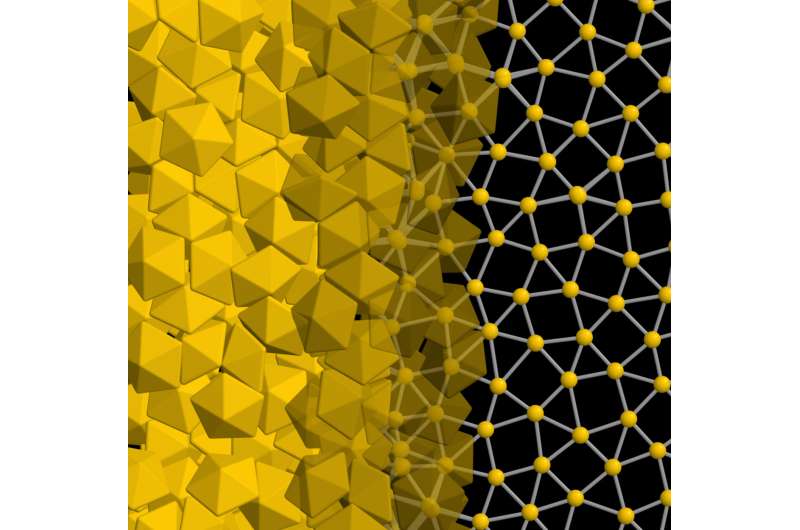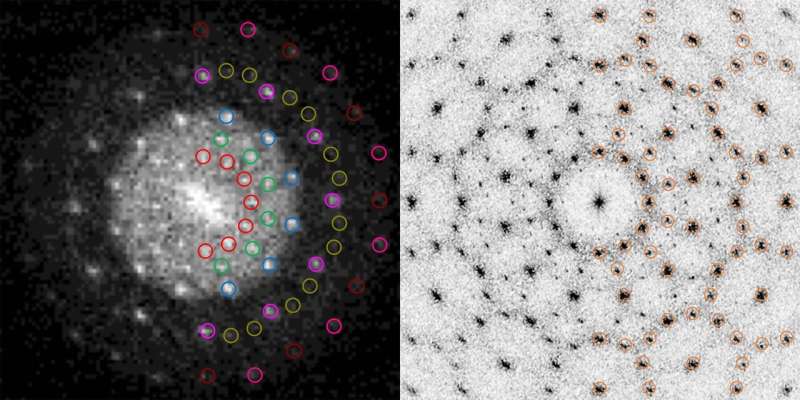This article has been reviewed according to Science X's editorial process and policies. Editors have highlighted the following attributes while ensuring the content's credibility:
fact-checked
peer-reviewed publication
trusted source
proofread
Researchers engineer colloidal quasicrystals using DNA-modified building blocks

A team of researchers from the Mirkin Group at Northwestern University's International Institute for Nanotechnology in collaboration with the University of Michigan and the Center for Cooperative Research in Biomaterials- CIC biomaGUNE, unveils a novel methodology to engineer colloidal quasicrystals using DNA-modified building blocks. Their study is published in the journal Nature Materials under the title "Colloidal Quasicrystals Engineered with DNA."
Characterized by ordered yet non-repeating patterns, quasicrystals have long perplexed scientists. "The existence of quasicrystals has been a puzzle for decades and their discovery appropriately was awarded with a Nobel Prize," said Chad Mirkin, the study's lead researcher.
"Although there are now several known examples, discovered in nature or through serendipitous routes, our research demystifies their formation and more importantly shows how we can harness the programmable nature of DNA to design and assemble quasicrystals deliberately."
The focal point of the study was the assembly of decahedral nanoparticles (NPs)—particles with 10 sides—utilizing DNA as a guiding scaffold. Through a combination of computer simulations and meticulous experiments, the team unearthed a remarkable discovery: these decahedral NPs can be orchestrated to form quasicrystalline structures with intriguing five- and six-coordinated motifs, ultimately culminating in the creation of a dodecagonal quasicrystal (DDQC).

"Decahedral nanoparticles possess a distinctive five-fold symmetry that challenges the conventional periodic tiling norms," Mirkin said. "By leveraging the programmable capabilities of DNA, we were able to direct the assembly of these nanoparticles into a robust quasicrystalline structure."
The researchers functionalized decahedral gold nanoparticles with short, double-stranded DNA, and implemented a precisely controlled cooling process to facilitate the assembly. The resultant quasicrystalline superlattices exhibited medium-range quasiperiodic order, with rigorous structural analyses confirming the presence of twelve-fold symmetry and a distinctive triangle-square tiling pattern, hallmark features of a DDQC.
"Interestingly, the simulations discovered that, unlike most axial quasicrystals, the tiling pattern of the layers in the decahedron quasicrystal do not repeat identically from one layer to the next. Instead, a significant percentage of the tiles are different, in a random way. This randomness produces a disorder that helps to stabilize the crystal," said Sharon Glotzer, co-corresponding author of the study and chair of the department of chemical engineering at the University of Michigan.
The implications of this breakthrough are far-reaching, offering a potential blueprint for the controlled synthesis of other complex structures previously considered beyond reach. As the scientific community delves into the boundless prospects of programmable matter, this research paves the way for transformative advancements and applications in diverse scientific domains.
"Through the successful engineering of colloidal quasicrystals, we have achieved a significant milestone in the realm of nanoscience. Our work not only sheds light on the design and creation of intricate nanoscale structures but also opens a world of possibilities for advanced materials and innovative nanotechnology applications," said Luis Liz-Marzán, a senior co-author of the study from CIC biomaGUNE.
More information: Colloidal Quasicrystals Engineered with DNA, Nature Materials (2023). DOI: 10.1038/s41563-023-01706-x
Journal information: Nature Materials
Provided by Northwestern University





















